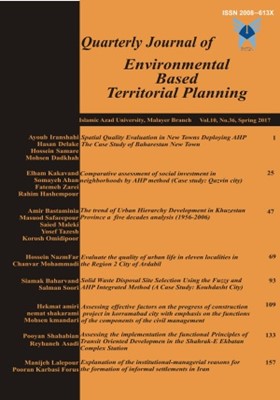Comparative assessment of social investment in neighborhoods by AHP method
(Case study: Qazvin city)
Subject Areas :
Elham Kakavand
1
,
Somayeh Ahani
2
,
Fatemeh Zarei
3
,
Rahim Hashempour
4
1 - M.A. Postgraduate of urban and regional planning . Department of urbanism and architecture Imam Khomeini international university, Iran.
2 - M.A. Postgraduate of urban and regional planning . Department of urbanism and architecture Imam Khomeini international university, Iran.
3 - M.A. Postgraduate student of urban planning, Young Researchers and elite Club, Qazvin Branch, Islamic Azad University, Qazvin, Iran.
4 - Professor and faculty member of Imam Khomeini international university
Received: 2015-04-11
Accepted : 2016-02-24
Published : 2017-05-22
Keywords:
AHP,
Qazvin,
Assessment,
social investment,
Partnership confidence,
Abstract :
Although the concept of social investment is a new and emerging field of urban studies, this concept is rooted in the social relations of mankind. Human naturally engages and interacts with others and satisfy their needs as living creatures. The effects of these interactions and their roles is complex; it is social capital avenue and it can be studied by various researchers.In this paper, by adopting a comparative approach to the evaluation components of social capital metrics awareness, participation and social trust among different communities, three regions of Qazvin had been paid attention. The research is undertaken using descriptive - analytical, qualitative data deploying a model designed to quantify and measure. Assessment model creating value tree and AHP method (AHP) and is designed with four levels .The findings of the study showed significant differences across social capital and its components.
References:
تبریزی محسنی، ع. آقا محسنی، م. 1389. بررسی سرمایه اجتماعی در توسعهی شهری، مورد پژوهی: شهر محلات، فصلنامه مدیریت شهری، تهران، شماره 26، 15-3.
توسلی، غ.، موسوی، ع و م. 1384. مفهوم سرمایه در نظریات کلاسیک و جدید، فصلنامه علوم اجتماعی، تهران، شماره 26، 21-10.
توکلی نیا، ج، شمس پویا، م .1394. تحلیل سرمایه اجتماعی با تاکید بر مشارکت شهروندی و پاسخگویی مدیران شهری (نمونه موردی: اسلامشهر) ، فصل نامه آمایش محیط، شماره 30 صفحه 137- 152
رجبی، آ. 1390. شیوههای مشارکت شهروندی درفرآیند های توسعه ی شهری، فصلنامه جغرافیایی آمایش محیط، دانشگاه آزاد اسلامی ملایر، ملایر، ایران، شماره 12، 110-102.
رفیعی، ز. 1388. محله گرایی و همبستگی اجتماعی، پایگاه اطلاع رسانی گزارش ایران، روزنامه همشهری.
زیاری، ک، شریفی، ا، نعیمی،ک ،1393، ارزیابی نقش توسعه اجتماعی در تحکیم حس مکانی، مطالعه موردی: محلات ناحیه 10 شهر سنندج، فصلنامه آمایش محیط ، سال چهارم، شماره چهاردهم، زمستان93
سجادی، ژ.، پور موسوی، م.، اسکندرپور، م. 1390 . بهسازی و نوسازی بافتهای فرسوده شهری با تأکید بر مشارکت مردمی (مطالعه موردی: محله دولاب تهران)، فصلنامه جغرافیایی آمایش محیط، دانشگاه آزاد اسلامی ملایر، ملایر، ایران شماره 14، 148-140.
شارع پور، م. 1383. فرسایش سرمایه اجتماعی و پیامدهای آن، انجمن جامعه شناسی ایران، نشر کلمه، تهران،88.
شماعی، ع،. پوراحمد، ا. 1384. بهسازی و نوسازی شهری از دیدگاه علم جغرافیا، تهران،110.
علی پور، ر. 1392. بررسی شاخصهای کیفیت محیط در شناسایی اولویتهای مداخله در محدودهی بافت فرسوده شهر بندر لنگه، فصلنامه باغ نظر، تهران: 9(209: 13-21).
فیروزآبادی، ا. 1384. سرمایه اجتماعی و عوامل موثر در شکلگیری آن در شهر تهران، دانشکده علوم اجتماعی دانشگاه تهران، 28-20.
فنی، ز.، صادقی، ی. 1388. توانمندسازی حاشیه نشینان در فرآیند بهسازی و نوسازی بافت فرسوده شهری، فصلنامه جغرافیایی آمایش محیط، دانشگاه آزاد اسلامی ملایر، ملایر، ایران شماره 7، 60-50.
قدسی پور، ح. 1381. تحلیل سلسله مراتبی AHP، مرکز نشر دانشگاه صنعتی امیر کبیر، تهران، 119.
کلمن، ج. 1988. بنیادهای نظریه اجتماعی، ترجمه منوچهر صبوری، نشر نی، تهران، 120.
نوابخش، م.، فدوی، ج. 1387. بررسی ابعاد سرمایه اجتماعی و نقش آن در توسعه شهری (مطالعه موردی منطقه 5 شهر تهران). پژوهش نامه علوم اجتماعی، شماره 3، 70-58.
Adler,P.S. 2002. Social Capital: Prospects for a New Concept, Academy of Management Review, 27(1), 20-32.
Bhushan, B. 1992. Directionary of sociology, Anmol Reperint, 109.
Felander, S. 2003. The internet, social capital and local, Ferlander, S.2003. the internet, social capital and local community thesis submitted for the degree of doctor philosophy, 210.
Eing of nations: the role of human and social capital. OECD: Paris, 42-52.
Fridman, John .1998. Toward a non – Eucldian mode of planning – APA journal, Autumn , 482.
Fukuyama, F. 1999. Social Capital and Civic Society, Conference on Second Generalization Reform, 10-21.
Gaoteri, H .1986. popular participation in development, in participation in development, Paris، VNESCO, 80.
Giddens , A. 1994. Beyond left & Right, Cambridage , polity press.
Gehl, J. 2004.Public life. Copenhagen: Danish architectural press, 5-18.
Key, A. 2005. Social capital, The Social economy and community development, Oxford. Development journal. Advance access publication 15 feb:162.
Gaoteri, H .1986. Popular participation in development in participation in development , Paris ,UNESCO.
Madanipour, A. 2001. How relevant is planning by neighbourhoods today in town planning, Review, 72(2),69-81.
Montgomery,J. 2006.Community strengthening through urban sociability, department for Victorian communities, urban cultures Ltd.
OECD (Organization for Economic cooperation and development). 2001. The wellb
Putnam, R. 2000. Bowling Alone: The Collapse and Revival of American Community, Simon and Schuster, New York, 42-55.
Requena, F. 2003. “Social capital, satisfaction and quality of life in the workplace”. Social Indicators Research. 61, pp 331-360.
Woolcock, M. 2000. Social Capital and Economic Development: Towards a Theoretical Synthesis and Policy Framework, Theory and Society, 27, 65-78.
Woolcock, M. 2001. The place of Social Capital in understanding Social and Economic Outcomes, ISUMA Canadian Journal of Policy Research, 2(1).
_||_


